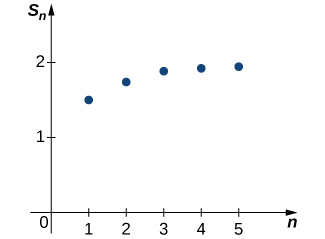
We have seen that a sequence is an ordered set of terms. If you add these terms together, you get a series. In this section we define an infinite series and show how series are related to sequences. We also define what it means for a series to converge or diverge. We introduce one of the most important types of series: the geometric series. We will use geometric series in the next chapter to write certain functions as polynomials with an infinite number of terms. This process is important because it allows us to evaluate, differentiate, and integrate complicated functions by using polynomials that are easier to handle. We also discuss the harmonic series, arguably the most interesting divergent series because it just fails to converge.
An infinite series is a sum of infinitely many terms and is written in the form
But what does this mean? We cannot add an infinite number of terms in the same way we can add a finite number of terms. Instead, the value of an infinite series is defined in terms of the limit of partial sums. A partial sum of an infinite series is a finite sum of the form
To see how we use partial sums to evaluate infinite series, consider the following example. Suppose oil is seeping into a lake such that
gallons enters the lake the first week. During the second week, an additional
gallons of oil enters the lake. The third week,
more gallons enters the lake. Assume this pattern continues such that each week half as much oil enters the lake as did the previous week. If this continues forever, what can we say about the amount of oil in the lake? Will the amount of oil continue to get arbitrarily large, or is it possible that it approaches some finite amount? To answer this question, we look at the amount of oil in the lake after
weeks. Letting
denote the amount of oil in the lake (measured in thousands of gallons) after
weeks, we see that
Looking at this pattern, we see that the amount of oil in the lake (in thousands of gallons) after
weeks is
We are interested in what happens as
Symbolically, the amount of oil in the lake as
is given by the infinite series
At the same time, as
the amount of oil in the lake can be calculated by evaluating
Therefore, the behavior of the infinite series can be determined by looking at the behavior of the sequence of partial sums
If the sequence of partial sums
converges, we say that the infinite series converges, and its sum is given by
If the sequence
diverges, we say the infinite series diverges. We now turn our attention to determining the limit of this sequence
First, simplifying some of these partial sums, we see that
Plotting some of these values in [link], it appears that the sequence
could be approaching 2.

Let’s look for more convincing evidence. In the following table, we list the values of
for several values of
| {: valign=”top”} |
| {: valign=”top”}{: .unnumbered summary=”This is a table with two rows and five columns. The first row is labeled “k” and has the values 5, 10, 15, and 20. The second row is labeled “S_k” and has the values 1.9375, 1.998, 1.999939, and 1.999998.” data-label=””}
These data supply more evidence suggesting that the sequence
converges to
Later we will provide an analytic argument that can be used to prove that
For now, we rely on the numerical and graphical data to convince ourselves that the sequence of partial sums does actually converge to
Since this sequence of partial sums converges to
we say the infinite series converges to
and write
Returning to the question about the oil in the lake, since this infinite series converges to
we conclude that the amount of oil in the lake will get arbitrarily close to
gallons as the amount of time gets sufficiently large.
This series is an example of a geometric series. We discuss geometric series in more detail later in this section. First, we summarize what it means for an infinite series to converge.
An infinite series is an expression of the form
For each positive integer
the sum
is called the
partial sum of the infinite series. The partial sums form a sequence
If the sequence of partial sums converges to a real number
the infinite series converges. If we can describe the convergence of a series to
we call
the sum of the series, and we write
If the sequence of partial sums diverges, we have the divergence of a series.
This website shows a more whimsical approach to series.
Note that the index for a series need not begin with
but can begin with any value. For example, the series
can also be written as
Often it is convenient for the index to begin at
so if for some reason it begins at a different value, we can reindex by making a change of variables. For example, consider the series
By introducing the variable
so that
we can rewrite the series as
For each of the following series, use the sequence of partial sums to determine whether the series converges or diverges.
satisfies
Notice that each term added is greater than
As a result, we see that
From this pattern we can see that
for every integer
Therefore,
is unbounded and consequently, diverges. Therefore, the infinite series
diverges.
satisfies
From this pattern we can see the sequence of partial sums is
Since this sequence diverges, the infinite series
diverges.
satisfies
From this pattern, we can see that the
partial sum is given by the explicit formula
Since
we conclude that the sequence of partial sums converges, and therefore the infinite series converges to
We have
Determine whether the series
converges or diverges.
The series diverges because the
partial sum
Look at the sequence of partial sums.
A useful series to know about is the harmonic series. The harmonic series is defined as
This series is interesting because it diverges, but it diverges very slowly. By this we mean that the terms in the sequence of partial sums
approach infinity, but do so very slowly. We will show that the series diverges, but first we illustrate the slow growth of the terms in the sequence
in the following table.
| {: valign=”top”} |
| {: valign=”top”}{: .unnumbered summary=”This is a table with two rows and seven columns. The first row is labeled “k” and has the values 10, 100, 1000, 10,000, 100,000, and 1,000,000. The second row is labeled “S_k” and has the values 2.92897, 5.18738, 7.48547, 9.78761, 12.09015, and 14.39273.” data-label=””}
Even after
terms, the partial sum is still relatively small. From this table, it is not clear that this series actually diverges. However, we can show analytically that the sequence of partial sums diverges, and therefore the series diverges.
To show that the sequence of partial sums diverges, we show that the sequence of partial sums is unbounded. We begin by writing the first several partial sums:
Notice that for the last two terms in
Therefore, we conclude that
Using the same idea for
we see that
From this pattern, we see that
and
More generally, it can be shown that
for all
Since
we conclude that the sequence
is unbounded and therefore diverges. In the previous section, we stated that convergent sequences are bounded. Consequently, since
is unbounded, it diverges. Thus, the harmonic series diverges.
Since the sum of a convergent infinite series is defined as a limit of a sequence, the algebraic properties for series listed below follow directly from the algebraic properties for sequences.
Let
and
be convergent series. Then the following algebraic properties hold.
converges and
(Sum Rule)
converges and
(Difference Rule)
the series
converges and
(Constant Multiple Rule)
Evaluate
We showed earlier that
and
Since both of those series converge, we can apply the properties of [link] to evaluate
Using the sum rule, write
Then, using the constant multiple rule and the sums above, we can conclude that
Evaluate
Rewrite as
A geometric series is any series that we can write in the form
Because the ratio of each term in this series to the previous term is r, the number r is called the ratio. We refer to a as the initial term because it is the first term in the series. For example, the series
is a geometric series with initial term
and ratio
In general, when does a geometric series converge? Consider the geometric series
when
Its sequence of partial sums
is given by
Consider the case when
In that case,
Since
we know
as
Therefore, the sequence of partial sums is unbounded and thus diverges. Consequently, the infinite series diverges for
For
to find the limit of
multiply [link] by
Doing so, we see that
All the other terms cancel out.
Therefore,
From our discussion in the previous section, we know that the geometric sequence
if
and that
diverges if
or
Therefore, for
and we have
If
diverges, and therefore
A geometric series is a series of the form
If
the series converges, and
If
the series diverges.
Geometric series sometimes appear in slightly different forms. For example, sometimes the index begins at a value other than
or the exponent involves a linear expression for
other than
As long as we can rewrite the series in the form given by [link], it is a geometric series. For example, consider the series
To see that this is a geometric series, we write out the first several terms:
We see that the initial term is
and the ratio is
Therefore, the series can be written as
Since
this series converges, and its sum is given by
Determine whether each of the following geometric series converges or diverges, and if it converges, find its sum.
The initial term
and the ratio
Since
the series converges to
we can see that this is a geometric series where
Therefore, the series diverges.
Determine whether the series
converges or diverges. If it converges, find its sum.
We now turn our attention to a nice application of geometric series. We show how they can be used to write repeating decimals as fractions of integers.
Use a geometric series to write
as a fraction of integers.
Since
first we write
Ignoring the term 3, the rest of this expression is a geometric series with initial term
and ratio
Therefore, the sum of this series is
Thus,
Write
as a fraction of integers.
By expressing this number as a series, find a geometric series with initial term
and ratio
Define a sequence of figures
recursively as follows ([link]). Let
be an equilateral triangle with sides of length
For
let
be the curve created by removing the middle third of each side of
and replacing it with an equilateral triangle pointing outward. The limiting figure as
is known as Koch’s snowflake.

of the perimeter of
Evaluate
to find the length of the perimeter of Koch’s snowflake.
of figure
Evaluate
to find the area of Koch’s snowflake.
denote the number of sides of figure
Since
is a triangle,
Let
denote the length of each side of
Since
is an equilateral triangle with sides of length
we now need to determine
and
Since
is created by removing the middle third of each side and replacing that line segment with two line segments, for each side of
we get four sides in
Therefore, the number of sides for
is
Since the length of each of these new line segments is
the length of the line segments in
the length of the line segments for
is given by
Similarly, for
since the middle third of each side of
is removed and replaced with two line segments, the number of sides in
is given by
Since the length of each of these sides is
the length of the sides of
the length of each side of figure
is given by
More generally, since
is created by removing the middle third of each side of
and replacing that line segment with two line segments of length
in the shape of an equilateral triangle, we know that
and
Therefore, the number of sides of figure
is
and the length of each side is
Therefore, to calculate the perimeter of
we multiply the number of sides
and the length of each side
We conclude that the perimeter of
is given by
Therefore, the length of the perimeter of Koch’s snowflake is
denote the area of each new triangle created when forming
For
is the area of the original equilateral triangle. Therefore,
For
since the lengths of the sides of the new triangle are
the length of the sides of
we have
Therefore,
Since a new triangle is formed on each side of
Writing out the first few terms
we see that
More generally,
Factoring
out of each term inside the inner parentheses, we rewrite our expression as
The expression
is a geometric sum. As shown earlier, this sum satisfies
Substituting this expression into the expression above and simplifying, we conclude that
Therefore, the area of Koch’s snowflake is
The Koch snowflake is interesting because it has finite area, yet infinite perimeter. Although at first this may seem impossible, recall that you have seen similar examples earlier in the text. For example, consider the region bounded by the curve
and the
-axis on the interval
Since the improper integral
converges, the area of this region is finite, even though the perimeter is infinite.
Consider the series
We discussed this series in [link], showing that the series converges by writing out the first several partial sums
and noticing that they are all of the form
Here we use a different technique to show that this series converges. By using partial fractions, we can write
Therefore, the series can be written as
Writing out the first several terms in the sequence of partial sums
we see that
In general,
We notice that the middle terms cancel each other out, leaving only the first and last terms. In a sense, the series collapses like a spyglass with tubes that disappear into each other to shorten the telescope. For this reason, we call a series that has this property a telescoping series. For this series, since
and
as
the sequence of partial sums converges to
and therefore the series converges to
A telescoping series is a series in which most of the terms cancel in each of the partial sums, leaving only some of the first terms and some of the last terms.
For example, any series of the form
is a telescoping series. We can see this by writing out some of the partial sums. In particular, we see that
In general, the kth partial sum of this series is
Since the kth partial sum can be simplified to the difference of these two terms, the sequence of partial sums
will converge if and only if the sequence
converges. Moreover, if the sequence
converges to some finite number
then the sequence of partial sums converges to
and therefore
In the next example, we show how to use these ideas to analyze a telescoping series of this form.
Determine whether the telescoping series
converges or diverges. If it converges, find its sum.
By writing out terms in the sequence of partial sums, we can see that
In general,
Since
as
and
is a continuous function,
Therefore, we conclude that
The telescoping series converges and the sum is given by
Determine whether
converges or diverges. If it converges, find its sum.
Write out the sequence of partial sums to see which terms cancel.
We have shown that the harmonic series
diverges. Here we investigate the behavior of the partial sums
as
In particular, we show that they behave like the natural logarithm function by showing that there exists a constant
such that
This constant
is known as Euler’s constant.
Evaluate
for various values of
as defined in part 1. show that the sequence
converges by using the following steps.
is monotone decreasing. (Hint: Show that
is bounded below by zero. (Hint: Express
as a definite integral.)
converges. The limit
is Euler’s constant.
is from
for a given integer
Prove that for
by using the following steps.
and
such that
express
as a telescoping sum by writing
Use the result from part b. combined with this telescoping sum to conclude that
to an accuracy of within
and the corresponding sequence of partial sums
where
the series converges if and only if the sequence
converges.
converges if
and diverges if
For
diverges.
is a telescoping series. The
partial sum of this series is given by
The series will converge if and only if
exists. In that case,
Using sigma notation, write the following expressions as infinite series.
Compute the first four partial sums
for the series having
term
starting with
as follows.
In the following exercises, compute the general term
of the series with the given partial sum
If the sequence of partial sums converges, find its limit
Series converges to
Series diverges because partial sums are unbounded.
For each of the following series, use the sequence of partial sums to determine whether the series converges or diverges.
In general
Series diverges.
(Hint: Use a partial fraction decomposition like that for
The pattern is
and the series converges to
(Hint: Follow the reasoning for
Suppose that
that
that
and
Find the sum of the indicated series.
State whether the given series converges and explain why.
(Hint: Rewrite using a change of index.)
diverges,
(Hint: Rewrite using a change of index.)
convergent geometric series,
convergent geometric series,
For
as follows, write the sum as a geometric series of the form
State whether the series converges and if it does, find the value of
and
for
converges to
and
for
and
for
converges to
and
for
Use the identity
to express the function as a geometric series in the indicated term.
in
in
in
in
Evaluate the following telescoping series or state whether the series diverges.
as
diverges
Express the following series as a telescoping sum and evaluate its nth partial sum.
(Hint: Factor denominator and use partial fractions.)
and
(Hint: Look at
A general telescoping series is one in which all but the first few terms cancel out after summing a given number of successive terms.
Let
in which
as
Find
in which
as
Find
Suppose that
where
as
Find a condition on the coefficients
that make this a general telescoping series.
Evaluate
(Hint:
Evaluate
Find a formula for
where
is a positive integer.
[T] Define a sequence
Use the graph of
to verify that
is increasing. Plot
for
and state whether it appears that the sequence converges.
converges to
is a sum of rectangles of height
over the interval
which lie above the graph of
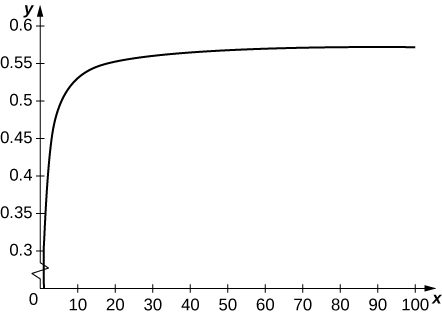
[T] Suppose that
equal uniform rectangular blocks are stacked one on top of the other, allowing for some overhang. Archimedes’ law of the lever implies that the stack of
blocks is stable as long as the center of mass of the top
blocks lies at the edge of the bottom block. Let
denote the position of the edge of the bottom block, and think of its position as relative to the center of the next-to-bottom block. This implies that
or
Use this expression to compute the maximum overhang (the position of the edge of the top block over the edge of the bottom block.) See the following figure.
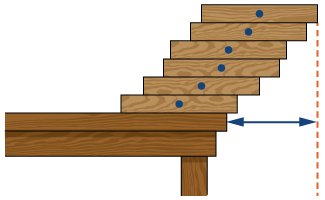
Each of the following infinite series converges to the given multiple of
or
In each case, find the minimum value of
such that the
partial sum of the series accurately approximates the left-hand side to the given number of decimal places, and give the desired approximate value. Up to
decimals place,
[T]
error
[T]
error
[T]
error
[T]
error
[T] A fair coin is one that has probability
of coming up heads when flipped.
times in a row?
a. The probability of any given ordered sequence of outcomes for
coin flips is
b. The probability of coming up heads for the first time on the
th flip is the probability of the sequence
which is
The probability of coming up heads for the first time on an even flip is
or
[T] Find the probability that a fair coin is flipped a multiple of three times before coming up heads.
[T] Find the probability that a fair coin will come up heads for the second time after an even number of flips.
[T] Find a series that expresses the probability that a fair coin will come up heads for the second time on a multiple of three flips.
[T] The expected number of times that a fair coin will come up heads is defined as the sum over
of
times the probability that the coin will come up heads exactly
times in a row, or
Compute the expected number of consecutive times that a fair coin will come up heads.
as can be shown using summation by parts
[T] A person deposits
at the beginning of each quarter into a bank account that earns
annual interest compounded quarterly (four times a year).
quarters is
years?
[T] Suppose that the amount of a drug in a patient’s system diminishes by a multiplicative factor
each hour. Suppose that a new dose is administered every
hours. Find an expression that gives the amount
in the patient’s system after
hours for each
in terms of the dosage
and the ratio
(Hint: Write
where
and sum over values from the different doses administered.)
The part of the first dose after
hours is
the part of the second dose is
and, in general, the part remaining of the
dose is
so
[T] A certain drug is effective for an average patient only if there is at least
mg per kg in the patient’s system, while it is safe only if there is at most
mg per kg in an average patient’s system. Suppose that the amount in a patient’s system diminishes by a multiplicative factor of
each hour after a dose is administered. Find the maximum interval
of hours between doses, and corresponding dose range
(in mg/kg) for this
that will enable use of the drug to be both safe and effective in the long term.
Suppose that
is a sequence of numbers. Explain why the sequence of partial sums of
is increasing.
[T] Suppose that
is a sequence of positive numbers and the sequence
of partial sums of
is bounded above. Explain why
converges. Does the conclusion remain true if we remove the hypothesis
[T] Suppose that
and that, for given numbers
and
one defines
and
Does
converge? If so, to what? (Hint: First argue that
for all
and
is increasing.)
Since
and since
If
for some n, then there is a smallest n. For this n,
so
a contradiction. Thus
and
for all n, so
is increasing and bounded by
Let
If
then
but we can find n such that
which implies that
contradicting that
is increasing to
Thus
[T] A version of von Bertalanffy growth can be used to estimate the age of an individual in a homogeneous species from its length if the annual increase in year
satisfies
with
as the length at year
as a limiting length, and
as a relative growth constant. If
and
numerically estimate the smallest value of
such that
Note that
Find the corresponding
when
[T] Suppose that
is a convergent series of positive terms. Explain why
Let
and
Then
eventually becomes arbitrarily close to
which means that
becomes arbitrarily small as
[T] Find the length of the dashed zig-zag path in the following figure.* * *
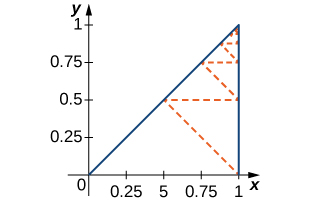
[T] Find the total length of the dashed path in the following figure.* * *
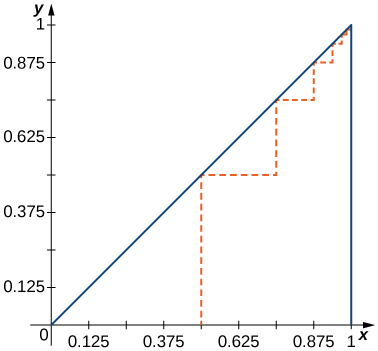
[T] The Sierpinski triangle is obtained from a triangle by deleting the middle fourth as indicated in the first step, by deleting the middle fourths of the remaining three congruent triangles in the second step, and in general deleting the middle fourths of the remaining triangles in each successive step. Assuming that the original triangle is shown in the figure, find the areas of the remaining parts of the original triangle after
steps and find the total length of all of the boundary triangles after
steps.* * *
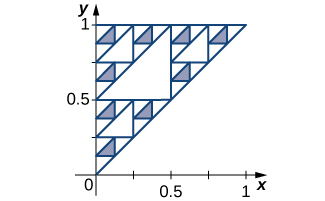
[T] The Sierpinski gasket is obtained by dividing the unit square into nine equal sub-squares, removing the middle square, then doing the same at each stage to the remaining sub-squares. The figure shows the remaining set after four iterations. Compute the total area removed after
stages, and compute the length the total perimeter of the remaining set after
stages.
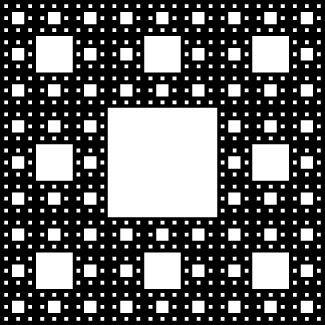
At stage one a square of area
is removed, at stage
one removes
squares of area
at stage three one removes
squares of area
and so on. The total removed area after
stages is
as
The total perimeter is
partial sum of the infinite series
is the finite sum

You can also download for free at http://cnx.org/contents/9a1df55a-b167-4736-b5ad-15d996704270@5.1
Attribution: